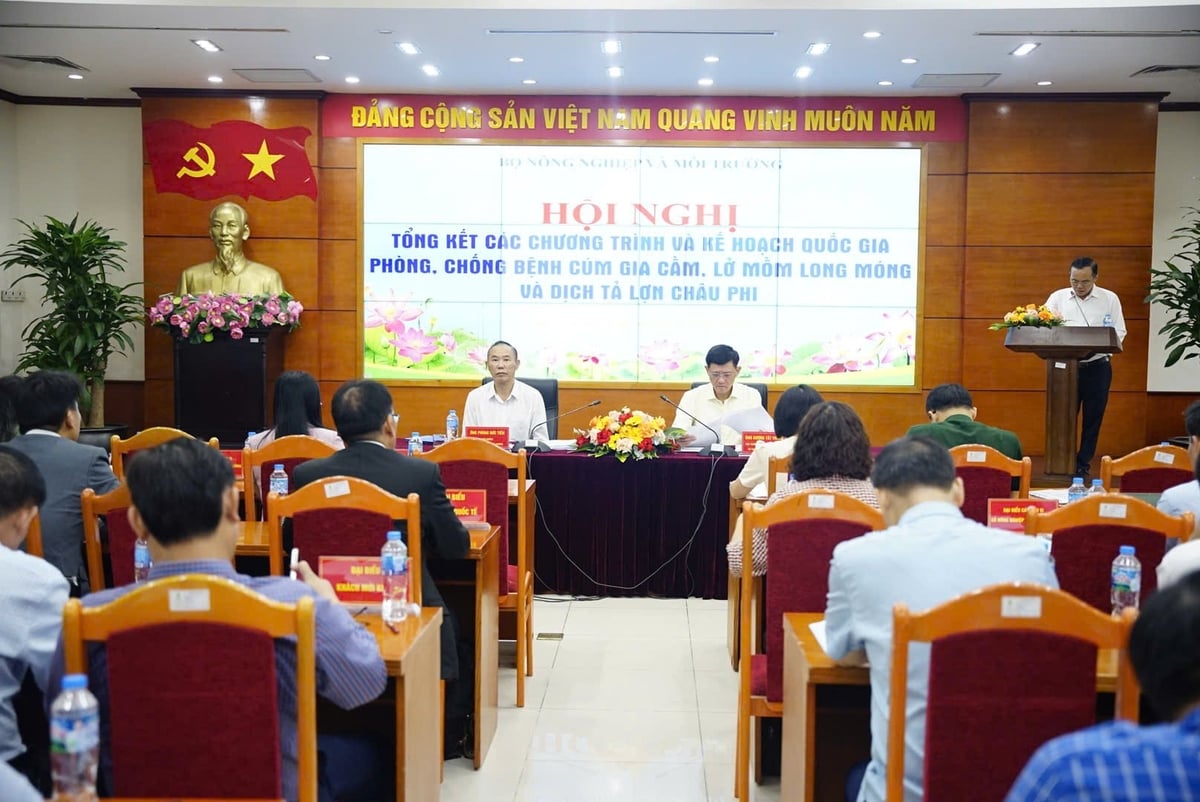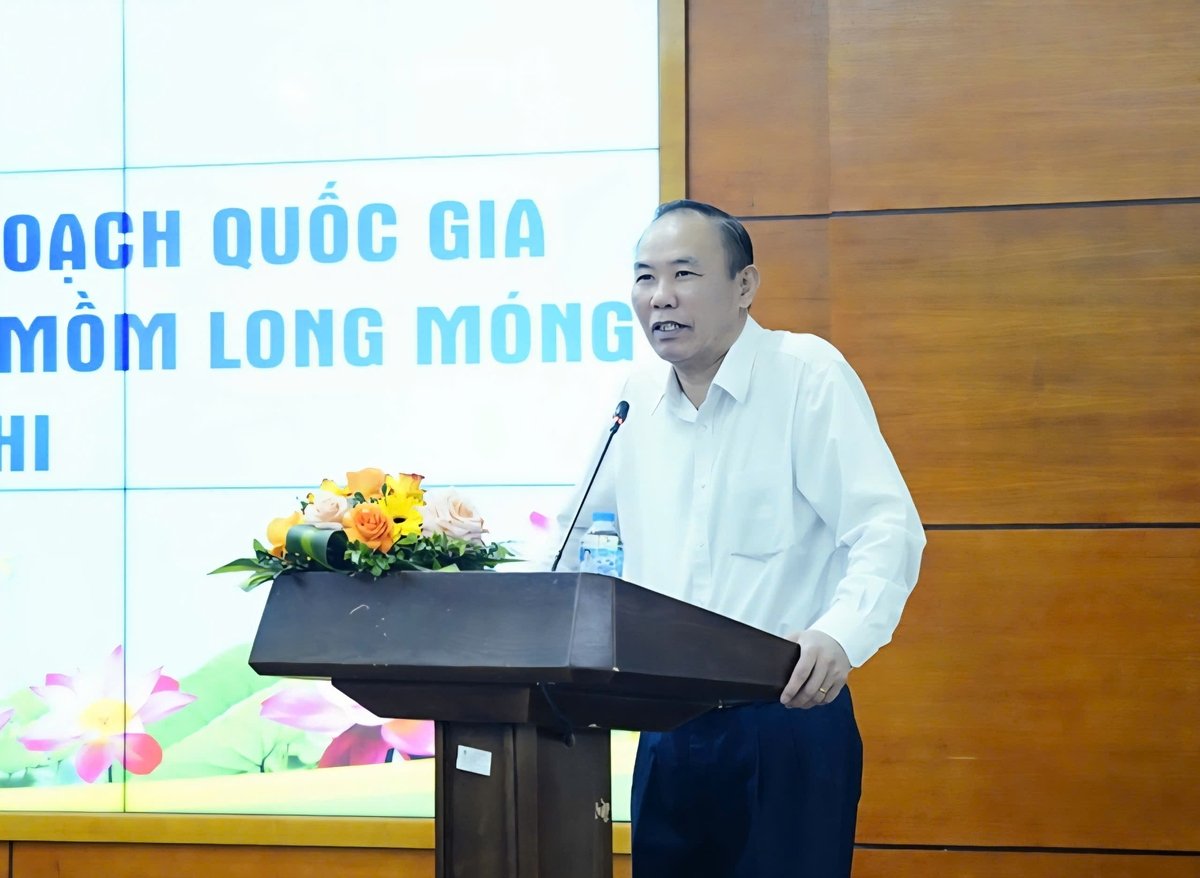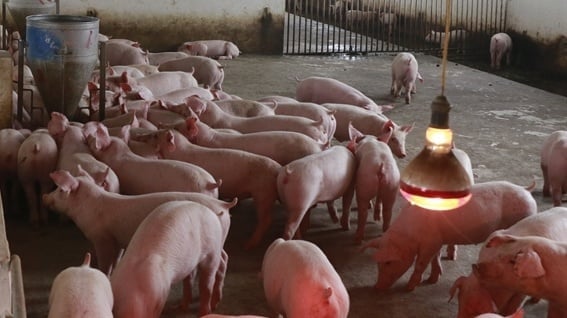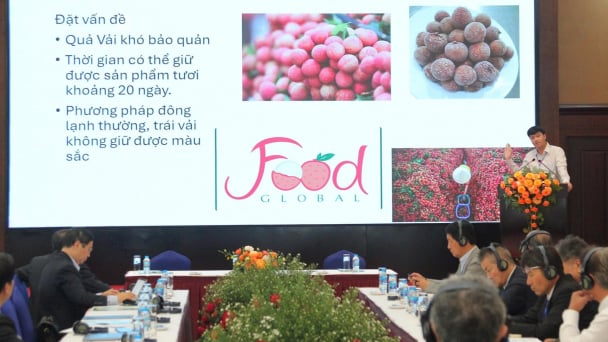June 17, 2025 | 20:53 GMT +7
June 17, 2025 | 20:53 GMT +7
Hotline: 0913.378.918
June 17, 2025 | 20:53 GMT +7
Hotline: 0913.378.918

Deputy Minister Phung Duc Tien (left) and Director of the Department of Livestock and Animal Health Duong Tat Thang chaired the Conference. Photo: Linh Linh.
On June 16, Deputy Minister of Agriculture and Environment Phung Duc Tien hosted a conference in Hanoi to evaluate the effectiveness of critical animal health initiatives that target avian influenza (AI), foot-and-mouth disease (FMD), and African swine fever (ASF) from 2019 to 2025. In addition to reviewing the results of the first half of 2025, the event also considered the years of evolution in Vietnam's approach to the prevention of animal diseases.
Phan Quang Minh, the Deputy Director of the Department of Livestock and Animal Health, stated that the first six months of 2025 have seen a relatively low rate of significant animal diseases. The number of ASF epidemics decreased to 251 cases in 35 provinces, representing a 14.6% decrease in affected regions and a 61.8% decrease in the total number of outbreaks year-over-year. Losses decreased by more than 81%.
Despite fewer provinces were affected, the total losses more than doubled compared to the same period last year, as AI epidemics occurred in six provinces, with nine confirmed clusters, affecting over 21,000 birds and resulting in the culling of more than 25,000. FMD experienced a 77% decrease in epidemics and a reduction of over 83% in cases, with 235 infected animals, 34 culled, and only 10 outbreaks recorded nationwide. In seven provinces, 88 cases of lumpy skin disease were found.
The implementation of proactive surveillance and early warning systems has been effective in preventing AI. The number of provinces reporting outbreaks decreased by 3.6%, and the average annual number of AI outbreaks decreased by 33% compared to the 2014–2018 period. Additionally, the VAHIS online disease reporting system has enhanced emergency response and real-time monitoring.
Vietnam has made significant progress under the national ASF control plan (2020–2025). Over 90% of communes had been ASF-free for the initial two years by mid-2025, over 95% for the two years followed, and over 99% by the final phase.
More than 580 pig farms have been certified as ASF-safe, far exceeding the original goal of 80. As of now, Vietnam has approved three ASF vaccines. The post-vaccination mortality rate was minimal (0.1%), with over 957,000 swine vaccinated in 45 provinces between 2023 and 2025. The majority of deaths pertained to piglets that were either already infected with field viruses or had weakened immunity due to other pathogens.
Based on field data, the vaccine has demonstrated efficacy in reducing outbreaks and reestablishing the national pig herd. This has helped stabilize pork supply and maintain consumer confidence.

Deputy Minister Phung Duc Tien speaks at the Conference. Photo: Linh Linh.
The FMD prevention program (2021–2025) also produced results. In comparison to the 2016–2020 averages, outbreaks and infection rates have decreased by 10–20%. Over 1,000 certified disease-free livestock circuits were constructed, and at least 10 FMD-free zones were established at the district or inter-district levels. It is worth noting that the World Organisation for Animal Health (WOAH) granted formal recognition to the program for its compliance with international standards.
Deputy Minister Tien expressed concern regarding the low vaccination rates, despite these accomplishments. Only 1.11% of pigs, 19.8% of poultry, and 25.5% of cattle had received state-funded vaccinations by mid-2025. Vaccination coverage for the majority of other diseases remained below 10%, particularly in small-scale and dispersed farms.
This shortfall is attributed to several factors: challenges in accurately tracking herd sizes, complex procurement procedures, limited budgets, and low public awareness. In certain provinces, the enforcement of vaccination regulations is not rigorous, which impedes the development of herd immunity.
According to Deputy Minister Tien, the livestock sector's three national disease control programs are particularly important in fostering agricultural development. He emphasized the significance of resilience by recalling previous epidemics. The 2003 AI outbreak resulted in the culling of 60 million birds and nearly 50 human fatalities, equivalent to a 0.5% loss of GDP. Similarly, the ASF epidemic that occurred from 2019 to 2020 resulted in a nine-million-ton swine shortage and a 6.73% increase in consumer prices in April 2020.
He noted that the dedication of government, industry, and veterinary networks facilitated the development of vaccines and the recovery of the sector following these crises.
Tien commended the collaborative efforts of local authorities, businesses, and farmers in implementing the three national plans and underscored that Vietnam's legal framework for livestock and veterinary governance is now essentially complete. We anticipate that the livestock sector will account for more than 60% of agricultural GDP by 2030, with a vision of 2045.

By mid-2025, the livestock and veterinary sector has nearly completed the target of over 90% of communes, wards and towns being free of ASF in the first two years. Photo: HT.
Nevertheless, he encouraged a comprehensive examination of the 2020–2025 period to identify both successes and shortcomings, thereby guaranteeing that the sector will achieve its $65 billion export objective and 8% growth target for the year.
The Deputy Minister identified several unresolved issues, including the persistent circulation of the AI virus, the challenge of managing mixed small- and large-scale agricultural systems, weak vaccination in remote areas, substandard slaughter and processing facilities, and gaps in livestock infrastructure. Increased awareness, stricter enforcement, and supportive policies will be necessary to address these issues.
Tien concluded that the results of national disease control programs form a vital foundation for building a modern livestock industry with strong biosafety standards—one capable of responding to disease threats while meeting domestic and export market demands.
Translated by Dieu Linh

(VAN) The UNESCO Global Geopark revalidation of Non nuoc Cao Bang and the transition to a two-tier administrative model are presently undergoing a pivotal moment in Cao Bang, the northernmost province of Vietnam.
/2025/06/13/5330-2-004539_953.jpg)
(VAN) Changing policy mindset and removing investment barriers are urgent requirements to open up new development space for enterprises in the agricultural sector.

(VAN) The areas include the restoration of five million hectares of marine ecosystems.

(VAN) Dr. Le Van Nguyen, Director of the Institute of E-Commerce Management (ECM), emphasizes the potential for green development through the cultivation of fruit trees, particularly in provinces such as Son La.

(VAN) VAAS and numerous Vietnamese enterprises have signed cooperation agreements with Japanese partners to promote agricultural technology and trade connectivity.
/2025/05/29/5625-12-214801_567.jpg)
(VAN) Provincial mergers in the Mekong Delta promise to streamline administration, expand inter-provincial raw material areas, and foster close linkages in agricultural value chains, benefiting both businesses and cooperatives.